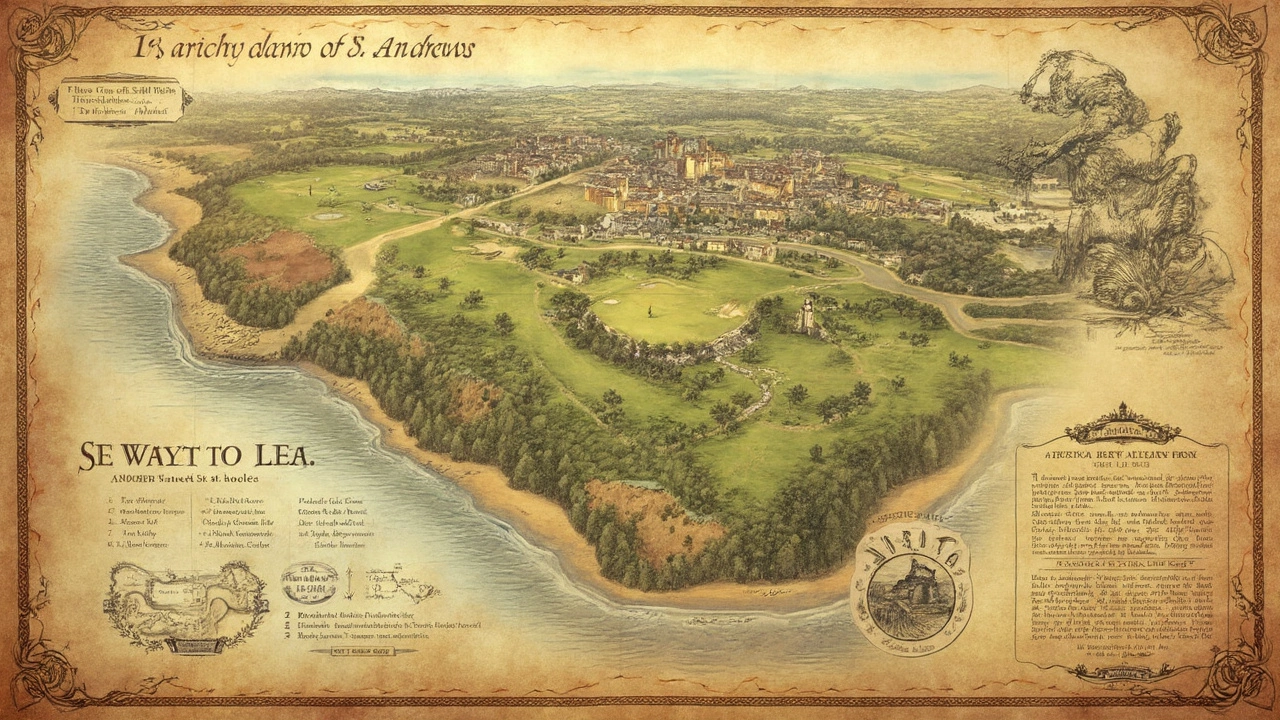Ever found yourself in the middle of a golf course, staring out at the lush green expanse, and suddenly wondered, 'Why exactly are there 18 holes?' It's not just some arbitrary decision. There's a storied history behind it that takes us back to the heartland of golf, Scotland. Intrigued? Let me share the tale.
It all started at St. Andrews, known as the “Home of Golf.” Initially, courses didn’t follow a set number of holes. It wasn’t until 1764 that the Old Course at St. Andrews was reduced from 22 to 18 holes, not because of some grand plan but simply for practicality and efficiency—resulting in a more seamless play.
As time went on, other courses saw the logic behind this setup. The layout at St. Andrews became somewhat of a template, and by the late 19th century, 18 holes were seen as the 'proper' length for a course. This widespread adoption didn’t happen overnight but became the golden standard over the years.
- The Origin of 18 Holes
- St. Andrews' Influence
- Adoption as the Standard
- Fun Facts about Golf Holes
- Navigating a Standard Course
- Tips for Playing on an 18-Hole Course
The Origin of 18 Holes
The whole idea of why we have 18 holes on a golf course dates back to the iconic St. Andrews in Scotland. This place is pretty much the heart of golf, with history in every blade of grass, and it's where the modern game found its footing.
Back in the day, golf courses didn't always stick to 18 holes. In fact, before 1764, the Old Course at St. Andrews had 22 holes. However, during that year, something rather practical happened. They decided to combine four small holes into two, which brought the total down to 18. Yeah, it wasn't some master plan to change the game forever but a simple choice for better play and flowing the game more smoothly.
Golfers found that playing 18 holes was just the right amount—not too short, not too long. It became the model that golfers everywhere enjoyed, and before long, it started catching on around the golfing world. This led to 18 holes becoming the go-to standard, with St. Andrews setting the pace.
Here's a fun nugget: St. Andrews wasn't the only course experimenting with hole numbers back then. Some courses had anywhere from five to 25 holes. But the simple, elegant flow of 18 was unbeatable, making it the beloved structure we know today. Can you imagine trying to squeeze in more than 18 holes in a single round now?
St. Andrews' Influence
Now, let's talk about the legendary St. Andrews. This historical course isn't just a backdrop for inspiring golf stories—it's the place where the magic number '18' practically began. Back in the day, golf courses were like the wild west—everyone was doing their own thing with different numbers of holes.
Originally, the Old Course at St. Andrews boasted a whopping 22 holes, but in 1764, the decision was made to merge some shorter holes to streamline play. This led to the course we know today: the iconic 18-hole layout. Why 18, though? It wasn't some profound strategy; the reason was much simpler—they found it to enhance the flow and keep players happier and less fatigued.
This simple change had a ripple effect, influencing golf courses around the globe. Once St. Andrews set this new standard, others quickly followed suit, thinking, 'If it's good enough for St. Andrews, it's good enough for us!' This old Scottish course quietly became the template, and by the late 1800s, it was the benchmark other courses aspired to match.
But why does this layout still hold its status as the definitive standard decades later? Tradition, pure and simple. The charm of St. Andrews, combined with its historical significance, gave the 18-hole structure a sort of timeless seal of approval. Golf courses today embrace the standard because it offers the perfect balance of challenge and playtime.
Adoption as the Standard
So, how did golf courses universally embrace 18 holes? It's more of a tale of influence and practicality than a grand design. Once St. Andrews established its 18-hole course in the 18th century, it became a beacon for others simply due to its prestige.
Back then, the St. Andrews course was synonymous with golf. Other courses wanted to replicate its success and structure, and having 18 holes just seemed like the sophisticated thing to do. In the early 1900s, the United States Golf Association (USGA) and the Royal and Ancient Golf Club of St. Andrews (R&A) came about to standardize golf rules worldwide, further cementing 18 holes as the norm.
"There's an innate elegance in 18 holes—it provides just the right balance, endurance, and enjoyment," remarks Peter Dawson, a former esteemed head of the R&A.
By design or not, 18 holes offer a satisfying rhythm to the game. It ideally balances various elements—time commitment, physical exhaustiveness, and the thrill of tackling different terrains. Plus, breaking it into two 9-hole segments makes stopping for a clubhouse break all the more tempting.
Why Not More or Less?
You might wonder why not stick with fewer holes to save space or costs? Turns out, 18 holes became what players expected. Anything else just doesn't feel like 'real' golf for many enthusiasts. And besides, changing the language of golf isn't easy—terms like 'front nine' and 'back nine' have nestled into the very lexicon of the sport.
Statistics back up this trend. According to a report by the National Golf Foundation, about 87% of golf holes in the U.S. are on courses with 18 holes. Case in point: It's a tradition that has stood the test of time.

Fun Facts about Golf Holes
Bet you didn't know every golf hole has its quirks and stories. Let's dive into some fun facts that might just make your next golf holes experience more interesting.
The Evolution of the Cup
Back in the early days of golf, there was no standard size for the hole. Crazy, right? It wasn't until 1829 that the cup was standardized to 4.25 inches in diameter at Musselburgh, Scotland. That's kind of fascinating considering how this simple change led to uniformity across the globe.
What’s in a Name?
Ever wondered why some holes are called unique names like 'The Road Hole' or 'The Postage Stamp'? These holes often have names based on local landmarks or distinctive features. They add a little personality to the course, don't you think?
- The Road Hole on the Old Course at St. Andrews is famous for its challenging design.
- The 'Postage Stamp' at Royal Troon is another fun hole known for its tiny green.
World's Longest and Shortest Holes
The shortest hole in professional golf can be found at TPC Sawgrass, the notorious 17th, known as 'Island Green.' And for those who love extremes, the longest hole is the 7th at Satsuki Golf Club in Japan, measuring a whopping 964 yards! That's a par 7, folks.
Golf by the Numbers
| Stat | Value |
|---|---|
| Average Number of Holes Played Annually (Globally) | About 450 million |
| Year the First 18-Hole Tournament was Played | 1860 |
So next time you're out there, remember that each hole has a story to tell. Maybe it’ll even improve your game!
Navigating a Standard Course
If you're hitting the green for the first time or just want to understand how to get around those golf courses efficiently, you're in the right spot. Navigating an 18-hole golf course can seem daunting, but it doesn't have to be.
Understanding the Layout
Most golf courses follow a similar structure: 18 holes divided into two sets of nine. You'll often hear them referred to as the 'front nine' and the 'back nine.' Typically, these include a mix of par 3, par 4, and par 5 holes, combining for a par score usually around 72. Keep this in mind as you plan your play.
Key Areas to Focus On
- Tee Box: Your starting point for each hole. Choose your club wisely and aim for smooth contact.
- Fairway: The clear, grassy path leading to the hole. Stay here as much as possible to avoid tricky roughs or sand traps.
- Green: The ultimate goal for each hole: where the pin resides. Master this area for putting success.
Smart Strategies for Each Hole
- Plan Your Approach: Before swinging, map out how you want to tackle the hole. Visualize your shots, and think two moves ahead.
- Club Selection: Always important. Different holes require different clubs based on distance and obstacles.
- Mind the Wind: It can drastically change the ball's flight. Adjust your swing based on wind speed and direction.
Let's say you’re on a par 4: focus on hitting the fairway off the tee, then a solid iron shot to get close to the green. Your putting game will rely on reading the slope and pace judiciously.
| Key Elements | Description |
|---|---|
| Tee Boxes | 3-4 sets based on skill level |
| Fairways | Narrow or wide, aim to stay central |
| Greens | Varied surfaces, skill in reading is crucial |
Remember, progression through an 18-hole course requires patience, precision, and planning. Each golf hole offers its unique challenges and potential. Observing these fundamentals and applying them practically during your game elevates your golfing experience.
Tips for Playing on an 18-Hole Course
Playing all 18 holes can seem like a mammoth task, especially if you're new to the game or just looking to improve. Let me give you some practical tips to make the most of your game and maybe lower that handicap.
1. Know the Course
Before you start, familiarizing yourself with the course layout can really help. Many modern courses offer apps that provide an overview of each hole. Check it out and plan your shots in advance. It saves time and frustration.
2. Pace Yourself
An 18-hole golf course isn't a sprint; it's more like a steady walk. It's easy to burn out if you play aggressively from the get-go. Take a breather between strokes. Stay hydrated, have a quick snack, and focus on consistency rather than power.
3. Choose the Right Equipment
Use clubs that match your skill level. Beginners tend to use irons and woods that are forgiving. Don’t let flashy, advanced gear throw you off your game. Find what feels comfortable and improves your swing.
4. Keep Your Eye on the Ball
Sounds simple, right? But you’d be surprised how often it's overlooked, especially under pressure. Keep your focus and block out distractions. The rest of the course can wait.
5. Warm Up and Practice
Arrive early and hit the driving range. A few practice swings can make a world of difference. It’s a chance to identify what's working for you that day, and to adjust before the real game begins.
6. Mind the Weather
Weather can change quickly, and it affects play. Wind can make a big difference, so adjust your shots accordingly. Pack light rain gear if needed. It keeps the game enjoyable whatever the skies throw your way.
7. Use Golf Course Etiquette
On a golf course, respecting the rules and fellow golfers keeps the atmosphere pleasant. Repair your divots, mark your ball on the green, and be aware of your pace. These small gestures maintain the enjoyment for everyone.
Remember, the ultimate goal is to enjoy your time out there. With these tips, you'll be on your way to mastering the 18 holes.





